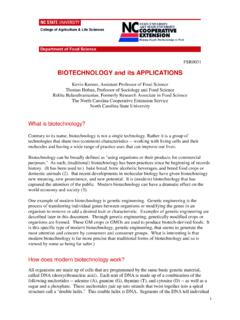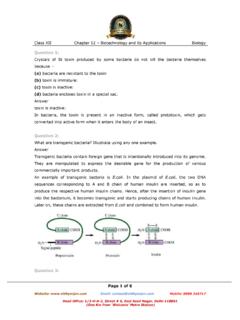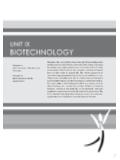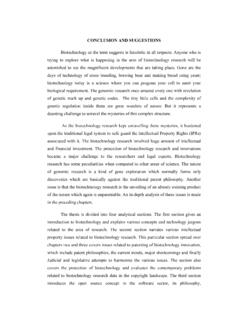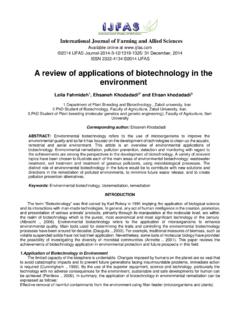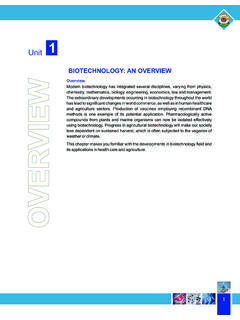Transcription of Biotechnology: Answers to Common Questions - FBNS
1 1 FSR0030 biotechnology : Answers to Common Questions Kevin Keener, Assistant Professor of Food Science Thomas Hoban, Professor of Sociology and Food Science Cooperative Extension Service State University We are entering the Century of Biology. Recent developments in the biological sciences are giving us a better understanding of the natural world. At the same type we are developing new tools that are collectively referred to as biotechnology . These help us address problems related to human health, food production, and the environment. Any new technology particularly one as far-reaching as biotechnology will generate interest, as well as concerns. Because the science behind biotechnology is complex, misconceptions arise over its impacts and implications. In this publication we will answer Questions many people have about biotechnology . These Questions are organized along the lines of a news story: what, when, who, where, why, and how.
2 We also provide a list of additional information sources available on the Internet. Our primary focus will be on the uses of biotechnology in agriculture and food production since these appear to be more controversial than other applications (at least up until this time). What is biotechnology ? In its broadest sense, biotechnology refers to the use of living systems to develop products. New scientific discoveries are allowing us to better understand fundamental life processes at the cellular and molecular level. Now we can improve selected attributes of microbes, plants, or animals for human use by making precise genetic changes that were not possible with traditional methods. All living organisms contain genes that carry the hereditary traits between generations. To understand biotechnology , it helps to compare genes with video tape. Both DNA and video tape are long, linear strings of information. This information is encoded in a particular way -- the genes encoded with DNA and the tape encoded with magnetic particles.
3 Both the tape and the genes can be copied (cloned), or edited (recombined). Tapes tend to be relatively stable, while DNA is quite dynamic. In nature, genes are continuously modified, and DNA is commonly transferred within and between species. 2 It helps to understand that modern biotechnology allows a single gene (from a strand of thousands of genes) to be changed, while traditional breeding involved random mixtures of many genes. Also, some end products of biotechnology (such as corn syrup or soybean oil) do not contain any genes; they are merely products of gene action. The fact is, when we eat, all food (whether obtained from modern biotechnology or traditional methods) is broken down into simple compounds (such as amino acids or fats) that are readily digested by our bodies. The following are some of the main applications of modern biotechnology : Microbes: biotechnology allows food scientists to improve the functionality of key food ingredients, such as enzymes.
4 For over a decade, we have consumed an improved cheese enzyme developed through biotechnology . Other uses include improved types of yeast for bread, better bacteria for yogurt, and new therapies to fight food-borne illness. Genetically modified microbes are routinely used in industry (including detergents and pollution clean-up). Plants: biotechnology has already been used to enhance to ability of plants to fight disease and pests. Many new crops are under development that will have enhanced nutritional content (such as rice enhanced with Vitamin A that will prevent childhood blindness and/or with iron to reduce the occurrence of anemia). It will also be possible to remove undesirable substances (such as allergens or saturated fats) from food. Such plant transformation is a refinement of traditional breeding with modern biotechnology scientists can add or remove small pieces of genetic information in a very precise manner, with a precise end result in mind.
5 Animals: biotechnology makes it possible to enhance the ability of livestock and pets to overcome disease and maintain health. This has already occurred through the use of improved animal medicines and other methods of disease treatment (many of which reduce the need for antibiotics, hormones, or other production tools.) It is now possible to improve animal feed to ensure better nutrition and reduce the amount of animal waste. biotechnology has also been used for many years to improve animal breeding, reproduction, and growth. Humans: Through advances in biology, scientists can better determine what genetic factors contribute to either wellness or disease. Using this information, it will be possible to intervene earlier in a disease through new medicines, lifestyle changes, better nutrition, and other approaches. Diagnostic tests will make it possible to better anticipate the development of a disease before it either begins or becomes advanced.
6 This will make it easier to practice prevention. When did we start Using biotechnology ? To some extent we have been using biotechnology for over 10,000 years. When our ancestors found a way to select and grow certain types of plants and animals, this was an early form of biotechnology . The industrial use of biotechnology actually started when people began using microbes to produce wine, bread, cheese, and other products (before the dawn of human history). 3 However, modern biotechnology began just over 100 years ago. In the mid-19th century, Charles Darwin described the processes of evolution and natural selection; while an Austrian monk Gregor Mendel discovered the laws of heredity. These opened the way to a better understanding of how species evolve and relate to their environment. In the mid-1950 s, Watson and Crick described the structure of DNA as a double helix. This was followed in the early 1970 s by the development of biotechnology techniques that allow for direct and precise modification of genetic information.
7 The first medical product of modern biotechnology was human insulin introduced in 1978. The first food product was the cheese enzyme, chymosin, approved for use in 1990. Since the mid-1990 s, the government has approved over 40 different plants developed through biotechnology . Who is Involved with biotechnology ? A wide range of companies, universities, interest groups and government agencies are involved with biotechnology . Each group has its own types of expertise, as well as its own concerns and interests. These groups often compete for public attention in their attempts to promote their position. The following describes the main actors in the biotechnology arena: Scientists working at universities, government agencies, or for industry are responsible for developing the scientific understanding and tools used in modern biotechnology . This sector also includes independent scientific organizations (such as the National Academy of Sciences and the American Dietetic Association) that have publicly confirmed the safety and benefits of biotechnology .
8 Government agencies including the United States Department of Agriculture (USDA), Food and Drug Administration (FDA), Environmental Protection Agency (EPA), National Institutes of Health (NIH), and others are responsible for ensuring that the products of biotechnology are safe for the public and the environment. There are also a number of international bodies involved with regulating biotechnology . Overall, there is much greater oversight and control of biotechnology than there has been for earlier scientific areas (such as traditional breeding). Companies take the discoveries about biotechnology and apply them to products. Small, entrepreneurial firms and larger established companies play important roles in this process. These firms will play an important role in our economy for decades to come. Farmers and other producers use the results from biotechnology research and developments to raise crops, process food, and create other useful products.
9 American producers are competing in a global market place. In order to survive economically, they need tools to ensure a profit. Consumer and environmental groups provide for a more balanced debate and careful evaluation of biotechnology . There are several main groups that are typically vocal on biotechnology . The first is the precautionary principle groups. They are 4 opposed to biotechnology because it is not natural . They want little or no risk at any costs. Other concerned groups either favor organic farming or distrust corporations. On the other hand, some consumer and environmental groups support agricultural biotechnology because they see it as a way to reduce the use of chemicals and increase agricultural yields with existing resources. Where is biotechnology Used? biotechnology will have an enormous impact on every sector of society from the farm to the home, as well as in a number of industries (such as manufacturing and health care).
10 The United States is currently the world s leader in biotechnology . Many of the most important and far-reaching discoveries in the new biosciences are coming from universities and companies in the United States. The major biotechnology research and development leading to new products are also taking place in the United States. In addition, US farmers have adopted new seed varieties developed through biotechnology faster than any previous agricultural innovation. Estimates of the percentage of US crop acreage planted to biotech crops in the year 2000 are as follows: Soybeans = 53%; Cotton = 65%; and; Corn = 26%. Farmers in other countries (including Canada, Argentina, and China) are embracing the products of biotechnology . Many other countries are active in biotechnology research and development. Despite some of the negative reaction against US grain, the European Union and Japan are, in fact, trying to catch up with the fast emerging technologies.
